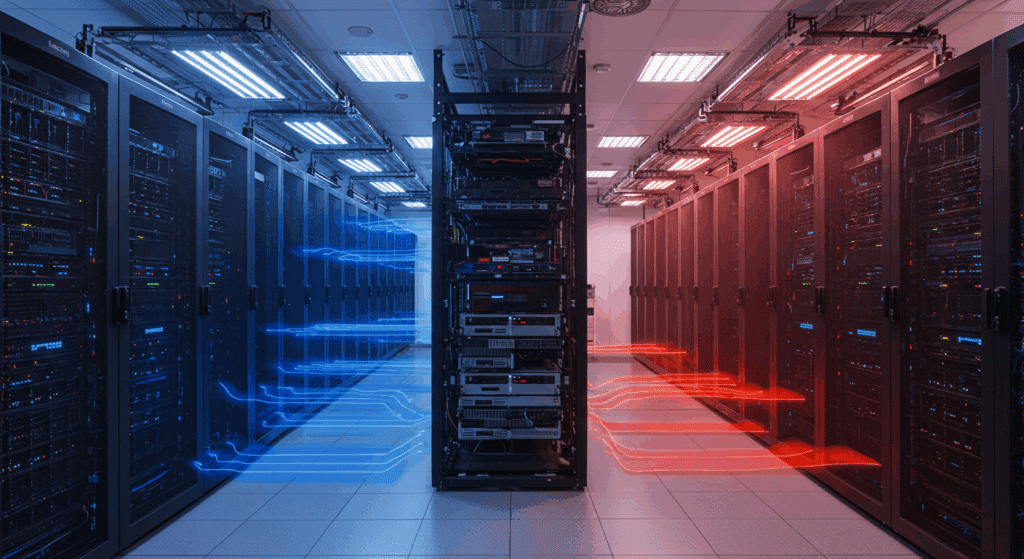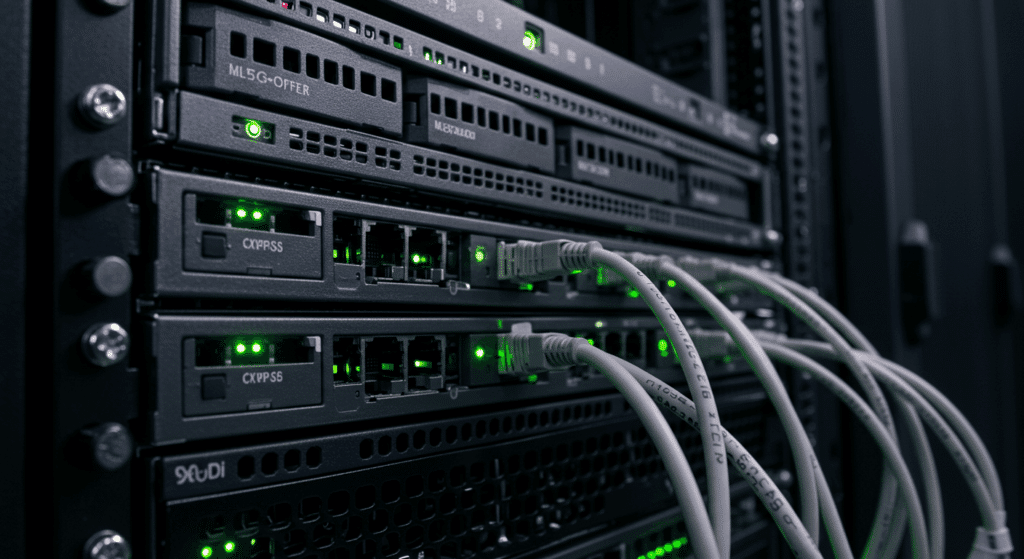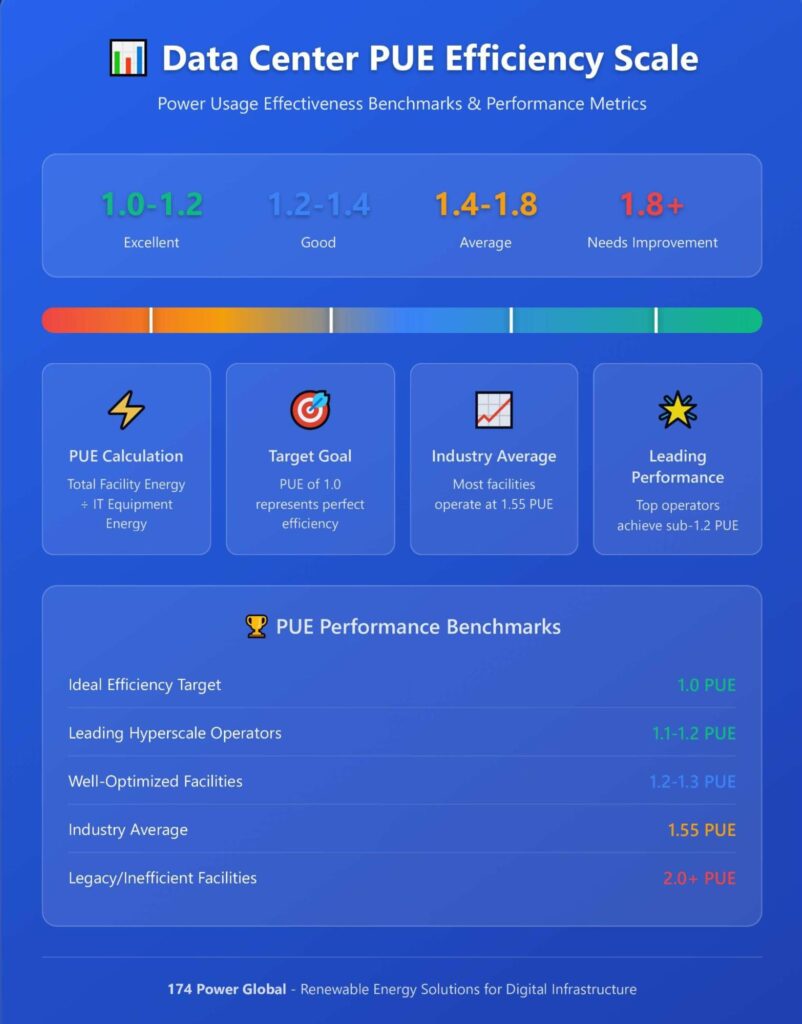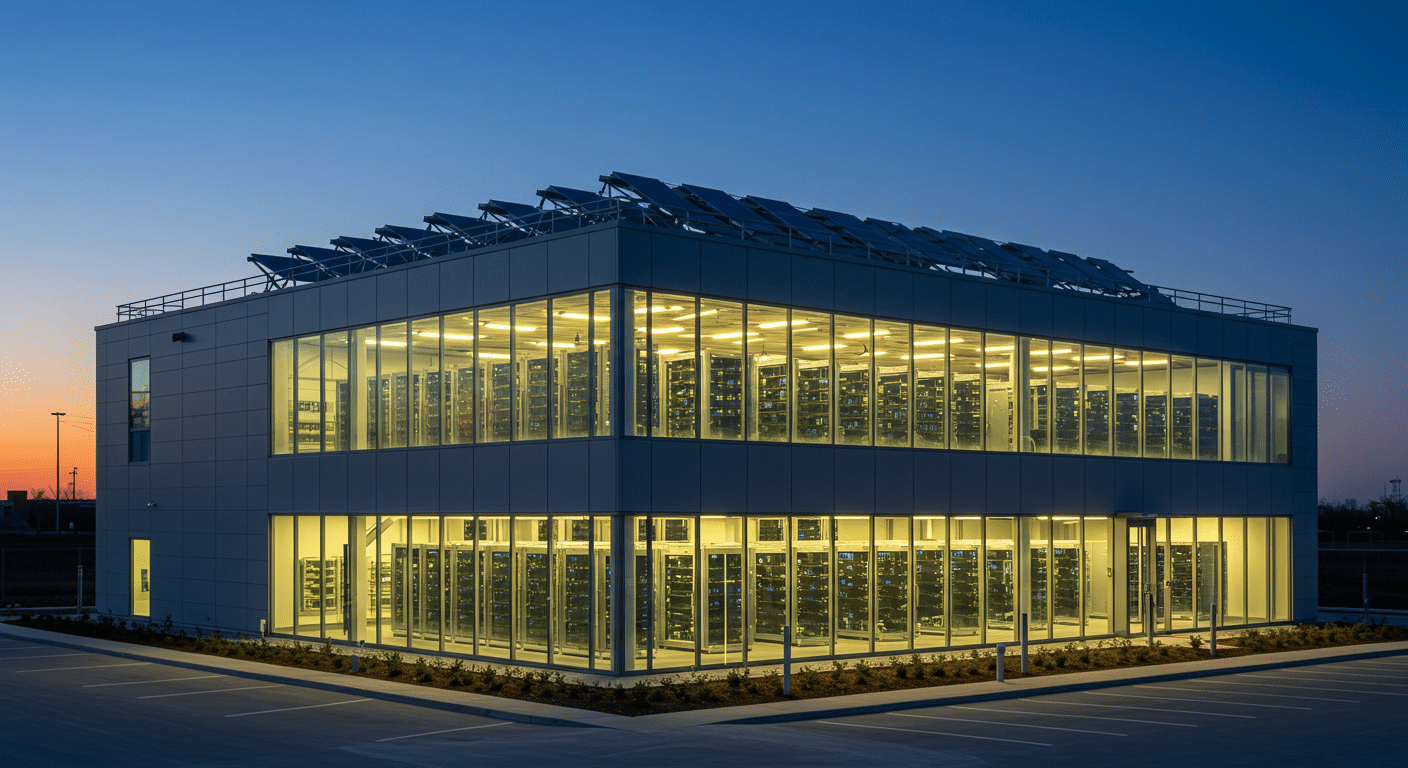Summary
Data centers that implement comprehensive energy efficiency strategies can significantly reduce operational costs while maintaining peak performance.
- Advanced cooling systems can dramatically cut energy consumption compared to traditional methods
- Regular energy audits identify optimization opportunities worth substantial annual savings
- IT infrastructure consolidation and virtualization improve server utilization substantially
- Renewable energy integration provides long-term cost stability and sustainability compliance
The most impactful approach combines multiple efficiency strategies rather than focusing on individual solutions.
Data center energy costs are spiraling out of control. According to the U.S. Department of Energy, energy consumption from information technology equipment has risen by approximately 36% since 2005, driven by explosive growth in internet usage and cloud computing demands. For data center operators, this represents both a massive cost burden and an urgent operational challenge that demands immediate action.
The stakes couldn’t be higher. Energy costs represent a massive operational burden for modern facilities, making data center energy efficiency best practices not just environmentally responsible but financially critical for survival. Forward-thinking operators who implement comprehensive efficiency strategies are seeing remarkable results, with some achieving substantial reductions in operational costs while maintaining or even improving performance standards.
Leading energy developers have witnessed firsthand how strategic energy efficiency implementations transform facility economics. The organizations that succeed aren’t just making incremental improvements – they’re fundamentally reimagining how data centers consume and manage power across every system and process.
Where Does Energy Go in Data Centers?
Before diving into specific best practices, it’s essential to understand where your facility’s energy goes. The Department of Energy reports that electricity consumed in data centers breaks down into equipment (50%) and HVAC systems (25-40%) to maintain optimal operating conditions.
Cooling systems represent the largest energy consumption category in most data centers, making them the primary efficiency opportunity. According to NVIDIA’s research, cooling systems consume approximately 40% of a data center’s total power. This massive consumption stems from the need to maintain optimal operating temperatures for increasingly dense server configurations.
IT equipment accounts for roughly 50% of energy use, while power distribution, lighting, and ancillary systems consume the remaining portion. Understanding this breakdown is crucial because efficiency improvements in cooling and power distribution create cascading benefits across all systems.
Most facilities track Power Usage Effectiveness (PUE) as their primary efficiency metric. PUE measures total facility energy divided by IT equipment energy, with the ideal score being 1.0. The industry average hovers around 1.55, while leading operators achieve significantly better performance through aggressive optimization strategies.
What Are the Most Effective Data Center Energy Efficiency Best Practices? 5 Essential Strategies
The following five strategies represent the most impactful approaches to reduce energy in data centers while maintaining optimal performance:
1. Advanced Cooling Solutions
Cooling optimization delivers the most immediate and substantial energy savings for most facilities. Traditional air-based cooling systems struggle with the heat densities generated by modern AI and high-performance computing workloads, creating massive inefficiencies that drain operational budgets.
Hot and Cold Aisle Containment represents the foundational cooling efficiency strategy. By physically separating cold intake air from hot exhaust air, facilities prevent wasteful mixing that forces cooling systems to work overtime. Properly implemented containment systems can improve cooling efficiency substantially with minimal capital investment.
The installation requires server racks arranged in alternating rows, with cold aisles facing each other and hot aisles doing the same. Physical barriers, doors, or ceiling panels then prevent air mixing. Empty rack spaces must be sealed with blanking panels to maintain separation integrity.

Liquid Cooling Technologies are becoming essential for high-density deployments. Direct-to-chip cooling systems deliver coolant directly to processors, eliminating the inefficiencies of air-based heat transfer. Advanced liquid cooling systems can reduce energy consumption by up to 95% compared to traditional air conditioning while enabling much higher server densities.
Immersion cooling takes this further by submerging entire servers in thermally conductive but electrically non-conductive fluid. This method provides superior heat dissipation while enabling unprecedented server density configurations.
Free Cooling Strategies leverage environmental conditions to reduce mechanical cooling loads. Economizer systems bring in outside air when temperatures permit, while evaporative cooling uses water evaporation to enhance cooling efficiency. These approaches work particularly well in moderate climates and can deliver substantial energy savings during cooler months.
2. Regular Data Center Energy Audits
Energy audits provide the roadmap for systematic efficiency improvements by identifying specific opportunities and quantifying potential savings. Without comprehensive auditing, operators are essentially flying blind when making efficiency investments.
Walk-through audits offer quick wins by identifying obvious inefficiencies like overcooling, equipment running unnecessarily, or poor airflow management. These basic assessments can identify significant opportunities for improvement.
Comprehensive audits examine three or more years of energy data and provide detailed analysis of all facility systems. They require larger investments but deliver investment-grade analysis that can identify substantial potential savings for large facilities.
Investment-grade audits include detailed energy models and financial projections for specific efficiency projects. While representing the highest investment level, they provide the documentation needed for major capital investments and financing decisions.
The audit process should evaluate cooling system performance, power distribution efficiency, IT equipment utilization, lighting systems, and building envelope performance. Modern audits also assess opportunities for renewable energy integration and energy storage deployment.
Key metrics to track include:
- Power Usage Effectiveness (PUE) trends over time
- Cooling system efficiency ratios
- Server utilization rates across different workloads
- Power distribution losses throughout the facility
- Environmental conditions and their impact on energy consumption
3. IT Infrastructure Optimization
IT optimization focuses on maximizing computational output while minimizing energy input. This requires both hardware and software strategies that work together to improve overall facility efficiency.
Server Virtualization and Consolidation can dramatically improve resource utilization. Traditional data centers often run servers at low utilization rates, representing massive waste. Through virtualization, organizations have improved utilization significantly, delivering immediate energy savings while reducing facility space requirements.
Containerization provides even greater efficiency by enabling multiple applications to share operating system resources. This lightweight virtualization approach reduces overhead and enables more granular resource allocation based on actual demand.

Dynamic Load Balancing distributes workloads across available resources to prevent hotspots and ensure optimal utilization. Modern orchestration platforms can automatically migrate workloads to the most efficient servers while powering down unused equipment during low-demand periods.
Hardware Selection plays a crucial role in long-term efficiency. Energy-efficient processors, solid-state drives, and high-efficiency power supplies can reduce equipment energy consumption substantially compared to older alternatives. The key is evaluating total cost of ownership rather than just initial purchase price.
Power Management Settings offer immediate efficiency gains with zero capital investment. Enabling processor power states, adjusting fan curves, and implementing sleep modes for idle equipment can reduce energy consumption across the facility.
4. Power Distribution Improvements
Power distribution efficiency improvements reduce energy losses throughout the electrical pathway from utility connection to individual servers. These “behind-the-scenes” improvements often deliver substantial savings that aren’t immediately visible but significantly impact overall facility economics.
Uninterruptible Power Supply (UPS) Optimization starts with right-sizing systems for actual loads rather than theoretical maximums. Operating UPS systems at optimal capacity typically provides peak efficiency, while running them near maximum capacity reduces efficiency and increases failure risk.
Modern UPS systems offer “eco-mode” operation that can substantially improve efficiency by bypassing power conversion during normal operation. This provides significant energy savings while maintaining protection against power quality issues.
Power Distribution Unit (PDU) Selection affects efficiency throughout the facility. High-efficiency PDUs with built-in monitoring capabilities enable granular power tracking while minimizing distribution losses. Smart PDUs can automatically shed non-critical loads during peak demand periods to reduce utility costs.
Transformer Efficiency improvements through high-efficiency units can reduce distribution losses. While this seems small, it represents significant savings when applied to multi-megawatt facilities operating continuously.
Electrical System Design should minimize distribution distances and optimize voltage levels throughout the facility. Higher distribution voltages reduce current flows and associated losses, while strategic placement of electrical equipment reduces cable runs and related inefficiencies.
5. Renewable Energy Integration
Renewable energy integration provides long-term cost stability while meeting increasingly stringent environmental requirements. The most successful implementations combine multiple renewable sources with energy storage to create resilient, cost-effective power systems.
On-site Solar Installation can provide substantial portions of facility power requirements, particularly in regions with strong solar resources. Modern installations often include battery storage to capture excess generation for use during peak demand periods or grid outages.
Wind Energy Integration works well for facilities in areas with consistent wind resources. Wind generation often complements solar by providing power during different weather conditions and times of day, creating more consistent renewable output.
Energy Storage Systems are essential for maximizing renewable energy value. Battery storage enables facilities to store excess renewable generation for use during high-cost peak demand periods, while also providing backup power during outages.
Grid Interconnection Strategies allow facilities to sell excess renewable generation back to the grid while drawing power when renewable output is insufficient. Net metering arrangements can significantly improve project economics while providing grid stability benefits.
Power purchase agreements (PPAs) with renewable energy developers offer another path to renewable sourcing without on-site installation requirements. These contracts provide long-term price stability while meeting sustainability goals.
What Monitoring Systems Ensure Ongoing Efficiency?
Effective energy management requires sophisticated monitoring and control systems that provide real-time visibility into facility performance. Data Center Infrastructure Management (DCIM) platforms have evolved from nice-to-have tools into mission-critical systems for modern facility operations.
- Real-time Monitoring Capabilities should track energy consumption at granular levels throughout the facility. This includes individual server racks, cooling systems, lighting circuits, and ancillary equipment. Granular monitoring enables operators to identify efficiency problems quickly and measure the impact of optimization efforts.
- Predictive Analytics use machine learning algorithms to identify patterns and predict equipment failures before they occur. This prevents energy waste from failing equipment while enabling proactive maintenance that maintains optimal efficiency.
- Automated Control Systems can adjust cooling, lighting, and other systems based on real-time conditions and demand forecasts. These systems respond faster than human operators while maintaining optimal efficiency around the clock.
- Energy Benchmarking compares facility performance against industry standards and similar facilities. This helps identify areas where performance lags and quantifies the potential value of efficiency improvements.
How Do You Measure Data Center Energy Efficiency Success?
Success in reducing energy in data centers requires tracking the right metrics and establishing meaningful benchmarks. The most effective operators focus on a balanced scorecard that includes efficiency, reliability, and cost metrics.
Power Usage Effectiveness (PUE) remains the industry standard efficiency metric, but it should be measured consistently and compared against facilities with similar characteristics. Seasonal variations and different measurement methodologies can significantly impact PUE calculations.

Data Center Infrastructure Efficiency (DCiE) provides the inverse perspective by measuring what percentage of total energy actually reaches IT equipment. A DCiE of 60% corresponds to a PUE of 1.67.
Carbon Usage Effectiveness (CUE) measures facility carbon emissions per unit of IT energy consumed. This metric becomes increasingly important as organizations pursue carbon neutrality goals.
Water Usage Effectiveness (WUE) tracks water consumption per unit of IT energy, which is crucial for facilities in water-scarce regions or those using evaporative cooling systems.
Cost per Unit of Compute provides a business-focused metric that considers both energy efficiency and computational output. This helps balance efficiency improvements against performance requirements.
What’s the Best Implementation Roadmap for Energy Efficiency?
Successfully implementing data center energy efficiency best practices requires a systematic approach that prioritizes high-impact, low-risk improvements while building toward more comprehensive optimizations.
Phase 1: Quick Wins (0-3 months) Start with no-cost improvements like optimizing temperature setpoints, enabling power management features, and sealing airflow leaks. These changes typically deliver immediate energy savings with minimal risk or investment.
Phase 2: Cooling Optimization (3-12 months) Implement hot/cold aisle containment and optimize existing cooling systems. These improvements often deliver substantial energy savings and provide the foundation for future enhancements.
Phase 3: IT Infrastructure Optimization (6-18 months) Focus on server consolidation, virtualization improvements, and equipment upgrades. This phase requires more careful planning but can deliver substantial efficiency gains.
Phase 4: Advanced Systems Integration (12-36 months) Deploy DCIM systems, advanced cooling technologies, and renewable energy systems. These comprehensive improvements require significant investment but provide long-term operational benefits.
Phase 5: Continuous Optimization (Ongoing) Establish regular monitoring, measurement, and improvement processes that maintain optimal efficiency as conditions change over time.
Frequently Asked Questions
How much can data center energy efficiency improvements actually save? Well-implemented efficiency programs typically deliver substantial reductions in energy costs. The exact savings depend on facility age, current efficiency levels, and the scope of improvements implemented. Newer facilities may see smaller percentage improvements, while older facilities often achieve dramatic savings.
What’s the typical payback period for efficient cooling system upgrades? Most cooling efficiency improvements pay for themselves within 18-36 months through reduced energy costs. Hot/cold aisle containment often provides faster payback, while advanced liquid cooling systems may require longer payback periods depending on facility utilization and energy rates.
How do you balance energy efficiency with reliability requirements? The best efficiency improvements actually enhance reliability by reducing stress on equipment and providing more stable operating conditions. Proper implementation includes redundancy and monitoring to ensure efficiency improvements never compromise uptime requirements.
What role does AI play in optimizing data center energy consumption? AI-powered management systems can optimize cooling, predict equipment failures, and automatically adjust systems based on workload patterns. These systems often deliver additional efficiency improvements beyond what human operators can achieve manually.
Should smaller data centers focus on the same efficiency strategies as hyperscale facilities? While the fundamental principles are similar, smaller facilities should prioritize improvements with lower complexity and faster payback periods. Hot/cold aisle containment, temperature optimization, and equipment consolidation often provide the best returns for smaller operations.
How Can You Start Implementing Data Center Energy Efficiency Today?
The data center industry stands at a critical inflection point. Rising energy costs, increasing computational demands, and growing environmental pressures are forcing operators to fundamentally reimagine how they approach facility efficiency. The organizations that act decisively today will secure competitive advantages that compound over time, while those that delay risk being left behind by both economic and regulatory changes.
Implementing comprehensive data center energy efficiency best practices isn’t just about reducing costs – it’s about building resilient, sustainable operations that can adapt to an uncertain energy future. The five strategies outlined here provide a proven framework for achieving substantial efficiency improvements while maintaining the reliability and performance that modern business demands require.174 Power Global specializes in developing integrated energy solutions that address the complete spectrum of data center power challenges. From renewable energy development to grid interconnection and energy storage, we help facilities achieve both immediate efficiency gains and long-term sustainability goals. Contact our team to explore how comprehensive energy solutions can transform your facility’s performance and economics.



